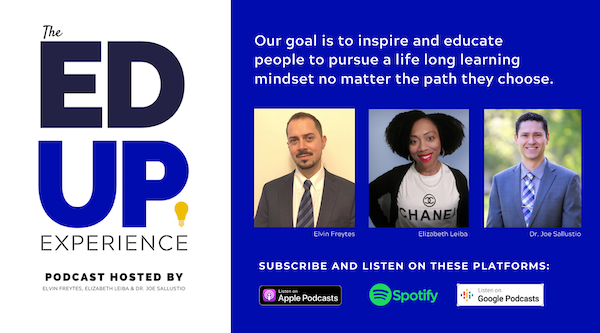Published on
Making College More Affordable and Transparent Going Forward

A shift to the remote environment has not only disrupted the education system but has also negatively impacted learners’ outlook on higher education and its value. With tuition costs already high, students are questioning why they should pay the same price for an off-campus experience. Institutions need to demonstrate their educational value while looking for more innovative solutions to cut down costs and make college more affordable. In this interview, Joe Sallustio, Elvin Freytes and Elizabeth Leiba from EdUp Experience speak to James Toscano about the public’s trust in higher education in light of the remote shift, resistance against OERS, and whether institutions will revert back to their old ways.
EdUp Experience: Could you tell us a little bit about your specialty—what you provide and your role there?
James Toscano (JT): We are a very young, national, non-profit organization dedicated to making college more affordable—mostly from the perspective of greater accountability and transparency in higher education. We have a very active pilot project underway in Virginia that’s focused on bringing about change mostly through state-level policy but also by putting some pressure on institutions through college trustees. That’s one thing that really makes our organization unique. But then also working at a grassroots level–not just with those who would influence lawmakers but students on campus and their families too.
EdUp Experience: How is the pandemic contributing to a lack of or an increase in public trust amongst higher-education universities?
JT: Our institutions are in a tough position. Those of us advocating for colleges and universities to do better need to take a deep breath and look at what’s happening before we share our criticisms. This is a time, not unlike for many other sectors of the economy, that is really new for higher education. Colleges have adjusted quickly by shifting remotely. Although there is a difference between remote and online learning, institutions still have done well in this shift. Many didn’t have a situation like this in their emergency plans. We know that there are certainly lessons to be learned going forward.
After this initial success, we’re starting to see some of the public trust that has been building for many years in higher education degrading. That’s now evident because students don’t believe they’re really getting their money’s worth with remote learning. Students are beginning to sue their institutions for this and expect refunds. That didn’t just come out of the blue. That happened through years of tuition-building in this country, and there’s a very complex explanation for why it happened. Nevertheless, this is where we are.
People are highly sensitive about cost, and a lot of questions are being raised among students. We’ll have to pay attention to institutions’ reactions and how they’re treating students who aren’t getting what they paid for.
EdUp Experience: Do you see an opportunity for innovators to communicate a repricing of some programs?
JT: We all hope that we can take something positive away from all the disruption occurring. Institutions might be at a competitive advantage if they price themselves lower than others.
We don’t currently see that, and we know that many private institutions have experimented with tuition resets and have seen a short-term bump in enrollment, which is positive. In truing the price of higher education, we stop the madness of increasing tuition with no ceiling and adding more institutional aid that gets washed out. We should be bringing the overall prices down and making it more affordable for everybody, and of course using targeted aid where it’s needed most.
I’m not sure that public institutions will take the opportunity to reset, even though they should, but they have the opportunity to do it today, especially those with resources. I see a similar approach to the problem as with the previous recession. The first thing the institution does is really clamor about how much the resources are threatened and how much more additional public aid is needed to fill those coffers. That’s not to de-legitimize that conversation, but it’s repeating past approaches in higher education. It’s yet to be determined whether a lot of innovation will come out of it.
This would be a time where a race to the bottom, in terms of tuition, would be a good thing. Of course, though, tuition is tied to the cost of delivery. We can’t drive down the price without getting into the gritty subject of what it costs to deliver the services that students need.
EdUp Experience: Why do you think there’s so much resistance to a widespread Open Educational Resources (OER)?
JT: The short answer is that institutions simply don’t have to—especially large public institutions. OER at scale is a great opportunity in the community college sector—that’s where I come from. Our business administration program was entirely comprised of OERs. There was a lot of skepticism at first, but students loved it, and they had great outcomes.
At community colleges, we talk about that student who is very sensitive to having to buy that book in the bookstore. There’s not the same friction in the transaction for that tuition payment. They may be taking out a loan but don’t necessarily see its immediate impact. But they do see it when it comes to textbooks and other things for which they might have to pull a credit card out.
Students at community colleges are particularly price-sensitive. These students are faced with deciding between purchasing textbooks or making other important payments in their lives. Therefore, OER should be widespread at community colleges.
In Virginia, we’ve been leading advocacy for expansion of OERs as an organization because we think it’s some really low-hanging fruit. Obviously, at institutions, there’s a lot of resistance. You probably have faculty who are really just dug in and don’t trust the way open educational resources work. They are skeptical about whether they are properly peer-reviewed. There’s confusion about that.
Community colleges can rise to this occasion, do it en masse, and really be the stars of open educational resources, then bring along the big universities kicking and screaming.
EdUp Experience: How have you recalibrated your plans in focusing on what’s needed to be done post-pandemic?
JT: It comes down to looking at how your mission is affected by COVID-19. There’s a lot of discussion about how things will be different, but I still want to wait and see before drawing conclusions. The traditional-age cohort in higher education doesn’t have the most severe symptoms. They’re more carefree. They’re not likely to be itching to get back to their normal routines on campus as much as the rest of us.
Others will likely take a gap year. They’ll wait till campuses figure things out before committing to an online degree program. That’s a particular risk for community colleges who traditionally benefit more from high unemployment rates.
There are a few things that we must continue doing as Partners for College Affordability and Public Trust, or the consumer will be worse off for it. One, there has to be a strong consumer advocate in higher education. If left to its own devices, the system will overlook the high degree of cost to students. We can’t let that happen. We have to stand in there and make sure that we’re making a case for our students.
EdUp Experience: Do you think there’s any chance that traditional higher education institutions revert immediately back to the way they were doing things before?
JT: Some absolutely will, but that risk exists throughout society. Many of us are hoping we can get back to doing things the way they were done. Some higher education institutions who probably can afford to do that, but they are largely not where the vast majority of Americans will get their higher education.
The highly selective institutions have a cushion because they have strong endowments. At the end of the day, their enrollments likely won’t take a big hit right now. People are always going to desire a higher education from those institutions; they’re always going to want to be associated with the brand. Even if they do receive fewer applications, they’ll just turn on the spigots and enroll students who don’t meet the previous academic standards. They’ll have the right mix of students from both an enrollment and business standpoint.
Other institutions just don’t have those capabilities. We’ve already seen an uptick in closures over the last few years. And those closures were expected to grow, independently of the pandemic. The pressure is going to be even greater on those institutions, and we’ll see more closures as a result. But we will see colleges go back to their way of life before but with some short-term strains on their finances. Those who aren’t highly reliant on state appropriations—those with the greatest demand for enrollment—are going to be in the best shape.
At the end of the day, this isn’t as much of a prognostication. This has been happening in higher education for a long time, and it’s going to be exacerbated. We’re going to have a growing divide in higher education–those who don’t have to worry about the greater market disruptions and those that do.
EdUp Experience: On your site, one of your values is “Students should not have to mortgage their economic future for a college degree.” Can you talk a bit about that?
JT: We don’t know what’s going to be on the other side of COVID-19. We do know that major domestic problems with similar economic impacts spawned a generation of fiscal constraint. They didn’t make wild investments and were fiscally conservative.
We don’t know what the psychological impact is going to be on those living through COVID-19. There’s skepticism about the value of college today. I’m a big believer that higher education is the single best ticket upward. But there’s no doubt that there may be a generation of students who look even more critically at the dollars they’re spending on higher education. They cannot live with the high price that they have to pay for college.
That will certainly have a profound effect on the way that we price college, on the enrollment patterns in this country and whether students try cheaper options. Maybe it’s shorter-term programs. Maybe it’s less than full-degree programs. We don’t know the answer to those things, but they’re big things that we’re all going to discover together as our nation grows through COVID-19.
EdUp Experience: What would you like to be remembered for and what does the future of education look like to you?
JT: I’d like to be remembered as somebody who did hard things, took on challenges, upset the status quo and delivered a better result for students. There’s a pattern in my professional life wherein I’ve had the opportunity to shake things up. We’ve shaken things up for the better in our organization for as long as we’ve been in existence. There’s great evidence of that in our work in Virginia.
We created a coalition for change in Virginia to change the fact that students had no right to speak in front of their boards of governors, their boards of trustees or regents, before tuition decisions were made. That was really out of the norm for public decision-making. In higher education, the culture is to keep the voices of our constituents outside of the decision-making process—whether that’s students, or faculty with strong governing structures.
In Virginia, we changed a law to afford every member of the public or student the right to address their board of trustees. Not only is it a good reform, but it’s also symbolic of what I want to be remembered for. Giving people the chance to have agency and advocate for themselves, to shake things up and change the governing structure. Sensitize those who make decisions to the plight of regular working people.
With the future of education, I hope I’m a part of a solution in higher education wherein we are agitating within the system so that innovators can recognize the market opportunity, bring down the cost of higher education and provide high-quality delivery to more people.
For my kids, some of them are doing it fully online, but it’s a high-touch, high-quality online program. I hope that some them are getting their degrees by transferring institutions—by first going to a community college and being put on a seamless pathway to a higher-level degree at a low cost. What we’re paying as a percentage of our household income in Virginia today for higher education is outlandish. Approximately, a third of household income is paid toward higher education in Virginia. That’s ridiculous. We’ve got to change these things. I hope it’s not one-size-fits-all but that there’s a great mix of options that my five children can enjoy and prosper from.
This interview was edited for length and clarity. To listen to the full interview, click here.
This is also a part of a collaborative series with EdUp Experience. To read their previous interview, click here.
Author Perspective: Administrator




